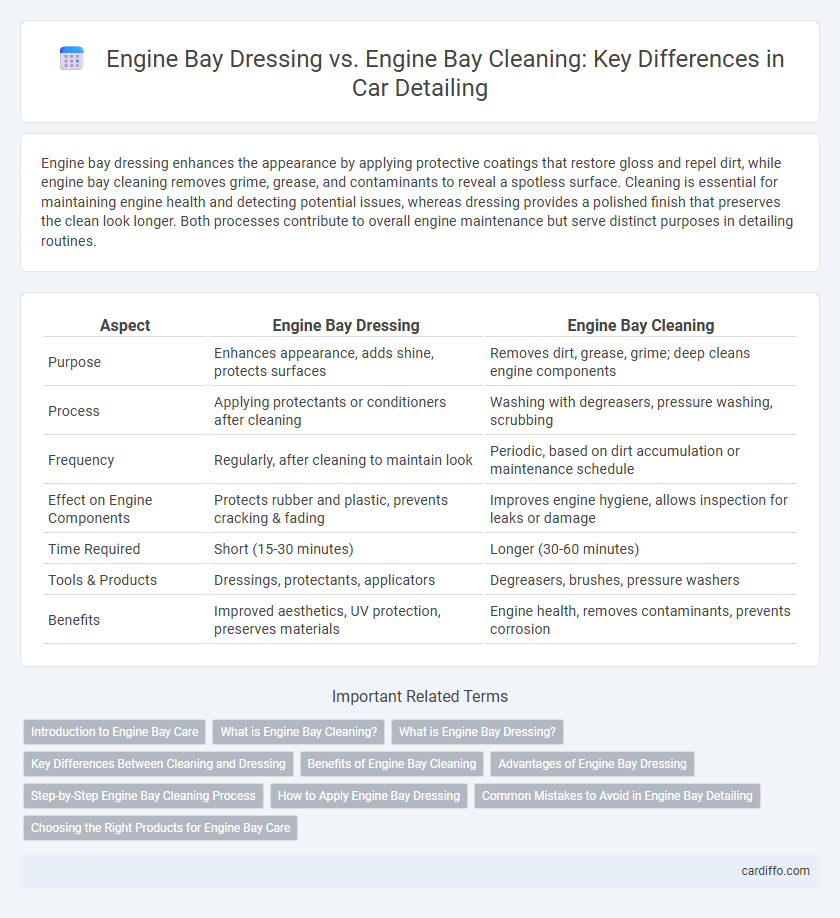Engine bay dressing enhances the appearance by applying protective coatings that restore gloss and repel dirt, while engine bay cleaning removes grime, grease, and contaminants to reveal a spotless surface. Cleaning is essential for maintaining engine health and detecting potential issues, whereas dressing provides a polished finish that preserves the clean look longer. Both processes contribute to overall engine maintenance but serve distinct purposes in detailing routines.
Table of Comparison
| Aspect | Engine Bay Dressing | Engine Bay Cleaning |
|---|---|---|
| Purpose | Enhances appearance, adds shine, protects surfaces | Removes dirt, grease, grime; deep cleans engine components |
| Process | Applying protectants or conditioners after cleaning | Washing with degreasers, pressure washing, scrubbing |
| Frequency | Regularly, after cleaning to maintain look | Periodic, based on dirt accumulation or maintenance schedule |
| Effect on Engine Components | Protects rubber and plastic, prevents cracking & fading | Improves engine hygiene, allows inspection for leaks or damage |
| Time Required | Short (15-30 minutes) | Longer (30-60 minutes) |
| Tools & Products | Dressings, protectants, applicators | Degreasers, brushes, pressure washers |
| Benefits | Improved aesthetics, UV protection, preserves materials | Engine health, removes contaminants, prevents corrosion |
Introduction to Engine Bay Care
Engine bay dressing involves applying protective and aesthetic products to enhance the appearance and preserve the surfaces of the engine compartment. Engine bay cleaning focuses on removing dirt, grease, and grime to maintain overall cleanliness and prevent potential damage from contaminants. Effective engine bay care combines thorough cleaning with targeted dressing to ensure both functionality and visual appeal.
What is Engine Bay Cleaning?
Engine Bay Cleaning involves the removal of dirt, grease, and grime from the engine compartment using specialized degreasers and pressure washing tools. This process ensures the engine bay is free from contaminants that can cause corrosion or damage to components. Regular engine bay cleaning improves vehicle longevity and enhances engine performance by maintaining a clean, operational environment.
What is Engine Bay Dressing?
Engine bay dressing is the application of protective and aesthetic products designed to restore shine and protect engine components from dirt, grime, and UV damage. Unlike engine bay cleaning which involves removing grease and contaminants with degreasers and pressure washing, dressing enhances the appearance by adding a glossy finish and preventing dust accumulation. Common engine bay dressings include silicone-based sprays and water-based protectants that are safe for rubber, plastic, and metal surfaces.
Key Differences Between Cleaning and Dressing
Engine bay cleaning primarily involves removing dirt, grease, and grime from engine components using degreasers, brushes, and pressure washers to restore cleanliness and prevent damage. Engine bay dressing focuses on applying protective and aesthetic products such as silicone or polymer-based sprays to hoses, plastics, and rubber parts, enhancing appearance and providing UV protection. The key difference is cleaning eliminates contaminants for maintenance, while dressing improves visual appeal and prolongs material lifespan.
Benefits of Engine Bay Cleaning
Engine bay cleaning removes grease, dirt, and debris that can cause corrosion or damage to engine components, improving vehicle longevity and performance. Thorough cleaning also helps in early detection of leaks or worn parts, preventing costly repairs. Clean engine bays enhance heat dissipation, reducing the risk of overheating and increasing overall engine efficiency.
Advantages of Engine Bay Dressing
Engine bay dressing enhances the appearance by providing a deep, glossy finish that protects surfaces from dirt, dust, and corrosion, extending the lifespan of engine components. It repels moisture and reduces the buildup of grime, reducing the frequency of thorough cleanings. The application of engine bay dressing also helps maintain a showroom-quality look, boosting vehicle resale value through improved visual appeal and perceived maintenance.
Step-by-Step Engine Bay Cleaning Process
Engine bay cleaning involves a thorough step-by-step process that includes covering sensitive components, degreasing surfaces, agitating grime with brushes, rinsing carefully, and drying with compressed air or microfiber towels to prevent moisture damage. Engine bay dressing, in contrast, is the final step after cleaning, applying protectants and conditioners to enhance appearance and preserve materials. Proper cleaning ensures dirt and contaminants are removed effectively before dressing to maintain optimal engine bay aesthetics and longevity.
How to Apply Engine Bay Dressing
Engine bay dressing enhances the appearance and protects surfaces by adding a layer of shine and barrier against dirt and grime. To apply engine bay dressing, first ensure the engine bay is thoroughly cleaned and dry, then use a dedicated applicator or microfiber cloth to evenly spread the product on plastic, rubber, and vinyl components. Avoid applying dressing on hot engine parts or electrical connections to prevent damage and ensure optimal results.
Common Mistakes to Avoid in Engine Bay Detailing
Overapplying dressing to an engine bay often traps dirt and moisture, leading to corrosion and reduced engine component lifespan. Using harsh cleaners incorrectly can damage wiring insulation and plastic parts, causing costly repairs. Avoid skipping the protective masking of sensitive electrical components to prevent short circuits and ensure a safe, effective engine bay detailing process.
Choosing the Right Products for Engine Bay Care
Engine bay dressing and engine bay cleaning require distinct products tailored to their specific purposes: cleaning demands degreasers and brushes for removing grime, while dressing focuses on protectants and silicone-based sprays to restore shine and protect surfaces. Selecting high-quality, non-corrosive, and heat-resistant products ensures effective maintenance without damaging engine components or wiring. Proper product choice enhances engine bay appearance, preserves materials, and extends the longevity of detailing results.
Engine Bay Dressing vs Engine Bay Cleaning Infographic

 cardiffo.com
cardiffo.com